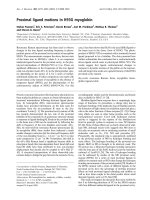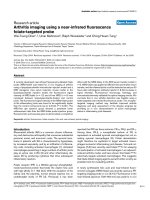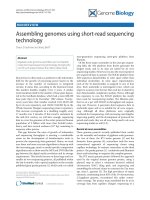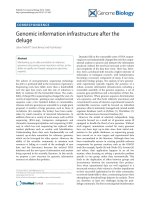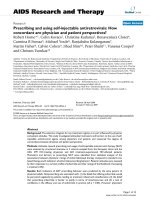Báo cáo y học: " Assembling genomes using short-read sequencing technology" pptx
Bạn đang xem bản rút gọn của tài liệu. Xem và tải ngay bản đầy đủ của tài liệu tại đây (140.43 KB, 4 trang )
Moore’s law is often used as a predictor in the informatics
fi eld for the growth of processing power based on the
increase in the number of transistors in integrated
circuits. It states that, according to the historical trend,
this number doubles roughly every 2 years. A similar
trend manifests itself in the number of base pairs deposi-
ted in the GenBank database, which had a mere 680,338
base pairs (bp) in its December 1982 release. Twenty-
seven years later, that number reached 110,118,557,163
bp in its core repository, and 158,317,168,385 bp in the
Whole Genome Shotgun sequencing project repository.
is increase corresponds to a doubling roughly every
17months over 3 decades. If this trend is sustained, by
the mid-21st century we will have enough sequencing
data to cover the genomes of the entire projected human
population of 9 billion with more than fi vefold redun-
dancy, and have several exabases (10
18
bp) remaining to
sequence other species.
is gap between the rates of growth of informatics
and sequencing throughput is exerting a considerable
strain on the development of bioinformatics tools to
process the sequencing data generated. Hence, we need
ever faster and more accurate algorithms to keep up with
this increasing gap, much as media-specifi c compression
algorithms such as those used by MP3 and DVD fi lled the
gap between the digital media revolution and its storage
requirements. is article focuses on three large and two
smaller de novo sequencing projects, all published within
the last 6 months, with a special emphasis on the recently
published giant panda genome [1], which used a so-called
next-generation sequencing (next-gen) platform from
Illumina.
Of the three major contenders in the next-gen sequen-
cing fi eld, the 454 platform from Roche generates the
longest reads, and so its data are suited for de novo
sequencing studies. However, it is also the most expensive
per sequenced base to operate. e SOLiD platform from
ABI sequences dinucleotides in color space rather than
individual nucleotides. In color space representation,
each of the 16 dinucleotides is assigned to one of four
dyes. Each nucleotide is interrogated twice, which can
improve accuracy, but the fact that each dye is shared by
four dinucleotides complicates analysis. Hence, although
less expensive to run, the SOLiD platform has mostly
been used for resequencing studies. e Illumina plat-
form is on a par with SOLiD in throughput and sequen-
cing cost. However, it generates short-sequence data in
nucleotide space and so is suitable for de novo sequen-
cing. Although all three platforms were originally
marketed for resequencing, with increasing read lengths,
improving quality, and the development of protocols for
paired-end reads, they are all now being used in de novo
sequencing studies as well [1,2].
Recent de novo assemblies
ree genome projects recently published their results
on the assembly and analysis of gigabase-scale genomes.
For two of these, the B73 maize genome [3] and the
domestic horse genome [4], researchers took the more
conventional approach of sequencing clones using
capillary technology. In contrast, researchers on the third
project - the panda genome [1] - exclusively used Illumina’s
short-read technology to sequence the complete genome.
e B73 maize genome project followed the approach
used by the original human genome project, using a
physical map to select a minimum bacterial artifi cial
chromosome (BAC) tiling path, and sequencing and
assembling the selected clones to construct the Zea mays
ssp. mays L. genome [3]. e high prevalence of repeat
elements, constituting about 85% of the 10-chromosome,
2.3-gigabase genome, necessitated this rather conser-
vative strategy. e project team assembled the 4x to 6x
coverage data from capillary (Sanger) sequencing of a
Abstract
Gigabase-scale genome assemblies are now feasible
using short-read sequencing technology, bringing the
cost of such projects below the million-dollar mark.
© 2010 BioMed Central Ltd
Assembling genomes using short-read sequencing
technology
Shaun D Jackman and İnanç Birol*
MINIREVIEW
*Correspondence:
Genome Sciences Centre, British Columbia Cancer Agency, Vancouver, British
Columbia V5Z 4E6, Canada
Jackman and Birol Genome Biology 2010, 11:202
/>© 2010 BioMed Central Ltd
BAC library of 16,848 clones using Phrap [5], confi rmed
the assembly by BAC end sequencing, and refi ned it by
sequencing 63 fosmid clones. e resulting assembly
contains 125,325 contigs (61,161 scaff olds) with a contig
(scaff old) N50 of 40 kb (76 kb), reconstructing 89% of the
genome, with N50 denoting the weighted median; for a
given assembly, half the genome is assembled in
contigs larger than its N50. The estimated cost of the
project, excluding the bioinformatics cost, is around
US$30million.
e project team for the domestic horse genome
reported the second version of the draft Equus caballus
genome [4], which has 31 pairs of autosomes and one pair
of sex chromosomes. Genome length is estimated to be
between 2.5 and 2.7 Gb. Sampling the genome of a
thoroughbred mare, three clone libraries were generated:
4-kb and 10-kb inserts, and 40-kb fosmids, yielding
sequence fold-coverages of 4.96x, 1.42x and 0.40x,
respectively, on the capillary sequencing platform to a total
of 6.8x coverage. To improve the contiguity of the draft
assembly, the team used end sequences of 314,972 BACs
derived from a half-brother of the sequenced mare. e
horse genome was assembled by Arachne 2.0 [6] to obtain
a contig (scaff old) N50 of 112 kb (46 Mb), with about 46%
of the assembled genome in repetitive sequences. e use
of a whole-genome shotgun approach reduced the cost of
this project to half that of the maize project.
e above two projects used capillary sequencing data.
In contrast, the giant panda genome project used
Illumina sequencing data with an average read length of
52 bp and 73x coverage to assemble the Ailuropoda
melanoleuca genome [1], which, at an estimated 2.4-2.5
Gb, is of comparable length to the other two genomes.
e assembly was performed in two stages using
SOAPdenovo [7]. In the fi rst stage, the project team used
paired-end sequencing data from 26 fragment libraries
with nominal fragment sizes ranging from 110 bp to
570 bp. In the second stage, they used the pairing
information from these libraries and from 11 long insert
libraries of lengths 2 kb, 5 kb and 10 kb in successive
iterations to scaff old the initial contigs. e resulting
draft assembly is reported to have a contig (scaff old) N50
of 40 kb (1.3 Mb), reconstructing an estimated 92% of the
genome. ey also report that 36% of the panda genome
is composed of transposable elements. e estimated
cost of sequencing for this project is well under $1
million, making it 25 to 50 times more cost-effi cient than
the B73 maize and horse genome projects.
e extensive use of the Illumina short-read tech nology,
and the longer reads from the 454 machine, for the de novo
assembly of shorter genomes have been reported at recent
conferences, and those studies have started to be published
[2,8-10]. Table 1 compares the three genome projects
described above and the recent genome assemblies of the
fi lamentous fungus Grosmannia clavigera (blue-stain
fungus) [2] and of the bacterial pathogen Pseudomonas
syringae pathovar tabaci 11528 [8], both of which used
next-gen sequencing.
Arguably, even if state-of-the-art sequencing protocols
and bioinformatics tools are used, genomes with high
repeat content, such as B73 maize, may still not yield to
short-read sequencing. However, if the success and the
quality of the paradigm used by the giant panda genome
project team is validated and reproduced, new de novo
sequencing projects for complex genomes will benefi t
from the reduction in cost as well as the time effi ciencies
off ered by the short-read technologies.
Assembly tools
e enabling paradigm behind the de novo assembly of
the giant panda genome is based on a de Bruijn graph
representation of short sequence overlaps. A de Bruijn
graph is a directed graph where vertices are strings of
length k and edges represent overlaps of k-1 symbols, or
nucleotides in the case of genome sequences. is
approach was introduced to the fi eld by Pevzner and co-
workers with the Euler software [11], and was made
popular by the software Velvet [12]. e fi rst application
of the technology for mammalian-sized genomes was
demonstrated by Simpson et al. using ABySS [13].
Table 1. Assembly statistics for maize, horse, panda, blue-stain fungus (G. clavigera) and P. syringae genomes
and their cost
B73 maize Domestic horse* Giant panda
†
G. clavigera
†
P. syringae
†
Genome length 2.3 Gb 2.5-2.7 Gb 2.4-2.5 Gb 32.5 Mb 6.1 Mb
Sequencing technology/ies Sanger Sanger Illumina Sanger, 454, Illumina Illumina
Number of contigs 125,325 55,316 198,274 3,361 1,346
Contig N50 40 kb 112 kb 40 kb 32 kb 11 kb
Number of sca olds 61,161 9,687 81,469 2,322 71
Sca old N50 76 kb 46 Mb 1.3 Mb 782 kb 317 kb
Estimated sequencing cost $30 million $15 million $0.6 million $100,000 $4,000
Contiguity statistics are calculated for *contigs and scaff olds 1 kb or longer and
†
contigs and scaff olds 100 bp or longer.
Jackman and Birol Genome Biology 2010, 11:202
/>Page 2 of 4
ese tools produce fi rst-pass draft assemblies using a
de Bruijn graph, followed by contig merging using paired-
end information. For the latter stage, several groups have
developed alternative ways of using the information in the
read pairs. e ALLPATHS algorithm [14] uses the paired-
end information in layers, starting with the large-fragment
libraries to build 20 kb regions, called neigh bor hoods,
around unique contigs, called seeds. e short-fragment
pairs are then used to assemble the neighborhood,
including the repetitive regions between the seeds. e
panda assembly [1] also used a similar layered approach to
using fragment libraries, but started with the shorter-
fragment libraries and proceeded to the longer-fragment
libraries.
e authors of Velvet suggest in a subsequent paper
[15] that shorter-fragment libraries may be unnecessary.
ey argue that distance between two nearby contigs can
be calculated by comparing their distances, estimated
using a large-fragment library, to a third more distant
contig. e distance between the two nearby contigs is
logically the diff erence between their distances to the
distant contig.
In ABySS [13], multiple libraries of diff erent sized frag-
ments are considered simultaneously. Distances between
pairs of contigs are estimated using each fragment library
on its own, and the most accurate distance estimates
between contig pairs, which typically come from the
library with the smallest fragments that span each
distance, are retained. After smaller contigs have been
merged into larger contigs, cases that could not be
resolved in previous iterations are then reconsidered.
Producing the best possible de Bruijn graph assembly
requires optimizing the fundamental parameter of k-mer
size, which determines the length of signifi cant overlaps
for contig growth. Li et al. [1] report obtaining a single-
end contig N50 of 1,483 bp using k = 27 with SOAPdenovo
[7]. Reassembling their cleaned sequence data using
ABySS 1.1.0 [13] without paired-end information, we
obtained a contig N50 of 1,381 bp using k = 27, and an
improved N50 of 1,952 using k = 35 (see Table 2). is
shows that although the contiguity of the fi nal panda
assembly is already adequate for a genome of this size, it
might be improved further by using a larger k-mer size.
e fi ve genomes noted in this article have diff erent
levels of completeness, and the cost estimates we report
are based on a number of assumptions and on the
summary numbers reported in the respective studies.
Furthermore, they exclude any costs related to the
bioinformatics activities. As such, the sequencing costs
are not directly comparable. Nevertheless, at face value, a
pattern emerges that favors the short-read technology.
is is not news, certainly, as it is the underlying premise
of the next-gen platforms, yet the short-read assembly
studies cited show that bioinformatics is catching up with
the pace of data generation by these platforms. us,
with software tools maturing and experimental protocols
being refi ned, the number of genomes assembled with
short reads will increase, and their size will expand.
Competing interests
The authors declare that they have no competing interests.
Published: 28 January 2010
References
1. Li R, Fan W, Tian G, Zhu H, He L, Cai J, Huang Q, Cai Q, Li B, Bai Y, Zhang Z,
Zhang Y, Wang W, Li J, Wei F, Li H, Jian M, Li J, Zhang Z, Nielsen R, Li D, Gu W,
Yang Z, Xuan Z, Ryder OA, Leung FC, Zhou Y, Cao J, Sun X, Fu Y, et al.: The
sequence and de novo assembly of the giant panda genome. Nature 2009,
463:311-317.
2. Diguistini S, Liao NY, Platt D, Robertson G, Seidel M, Chan SK, Docking TR, Birol
I, Holt RA, Hirst M, Mardis E, Marra MA, Hamelin RC, Bohlmann J, Breuil C,
Jones SJ: De novo genome sequence assembly of a fi lamentous fungus
using Sanger, 454 and Illumina sequence data. Genome Biol 2009, 10:R94.
3. Schnable PS, Ware D, Fulton RS, Stein JC, Wei F, Pasternak S, Liang C, Zhang J,
Fulton L, Graves TA, Minx P, Reily AD, Courtney L, Kruchowski SS, Tomlinson C,
Strong C, Delehaunty K, Fronick C, Courtney B, Rock SM, Belter E, Du F, Kim K,
Abbott RM, Cotton M, Levy A, Marchetto P, Ochoa K, Jackson SM, Gillam B,
etal.: The B73 maize genome: complexity, diversity, and dynamics. Science
2009, 326:1112-1115.
4. Wade CM, Giulotto E, Sigurdsson S, Zoli M, Gnerre S, Imsland F, Lear TL,
Adelson DL, Bailey E, Bellone RR, Blöcker H, Distl O, Edgar RC, Garber M, Leeb
T, Mauceli E, MacLeod JN, Penedo MC, Raison JM, Sharpe T, Vogel J,
Andersson L, Antczak DF, Biagi T, Binns MM, Chowdhary BP, Coleman SJ, Della
Valle G, Fryc S, Guérin G, et al.: Genome sequence, comparative analysis,
and population genetics of the domestic horse. Science 2009, 326:865-867.
5. Phrap [ />6. Batzoglou S, Ja e DB, Stanley K, Butler J, Gnerre S, Mauceli E, Berger B,
Mesirov JP, Lander ES: ARACHNE: a whole-genome shotgun assembler.
Genome Res 2002, 12:177-189.
7. SOAP: short oligonucleotide analysis package [.
cn/soapdenovo.html]
8. Studholme DJ, Ibanez SG, MacLean D, Dangl JL, Chang JH, Rathjen JP: A draft
genome sequence and functional screen reveals the repertoire of type III
secreted proteins of Pseudomonas syringae pathovar tabaci 11528. BMC
Genomics 2009, 10:395.
9. Steuernagel B, Taudien S, Gundlach H, Seidel M, Ariyadasa R, Schulte D,
Petzold A, Felder M, Graner A, Scholz U, Mayer KF, Platzer M, Stein N: De novo
454 sequencing of barcoded BAC pools for comprehensive gene survey
and genome analysis in the complex genome of barley. BMC Genomics
2009, 10:547.
10. Farrer RA, Kemen E, Jones JD, Studholme DJ: De novo assembly of the
Pseudomonas syringae pv. syringae B728a genome using Illumina/Solexa
short sequence reads. FEMS Microbiol Lett 2009, 291:103-111.
11. Pevzner PA, Tang H, Waterman MS: An Eulerian path approach to DNA
fragment assembly. Proc Natl Acad Sci USA 2001,
98:9748-9753.
12. Zerbino DR, Birney E: Velvet: algorithms for de novo short read assembly
Table 2. Eff ect of the choice of k-mer size on the single-end contig N50 for the giant panda assembly using ABySS 1.1.0
k-mer size 27* 30 32 34 35 36 37 38
Contig N50 (bp) 1,381 1,724 1,863 1,940 1,952 1,942 1,924 1,860
*The k-mer size used for the reported giant panda genome assembly [1].
Jackman and Birol Genome Biology 2010, 11:202
/>Page 3 of 4
using de Bruijn graphs. Genome Res 2008, 18:821-829.
13. Simpson JT, Wong K, Jackman SD, Schein JE, Jones SJ, Birol I: ABySS: a parallel
assembler for short read sequence data. Genome Res 2009, 19:1117-1123.
14. Butler J, MacCallum I, Kleber M, Shlyakhter IA, Belmonte MK, Lander ES,
Nusbaum C, Ja e DB: ALLPATHS: de novo assembly of whole-genome
shotgun microreads. Genome Res 2008, 18:810-820.
15. Zerbino DR, McEwen GK, Margulies EH, Birney E: Pebble and rock band:
heuristic resolution of repeats and scaff olding in the Velvet short-read de
novo assembler. PLoS ONE 2009, 4:e8407.
Jackman and Birol Genome Biology 2010, 11:202
/>doi:10.1186/gb-2010-11-1-202
Cite this article as: Jackman SD, Birol İ: Assembling genomes using
short-read sequencing technology. Genome Biology 2010, 11: 202.
Page 4 of 4
